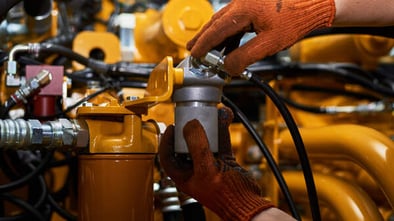Hydraulic system maintenance is critical to the service life of equipment and the safety of personnel. It is imperative that hydraulic maintenance technicians comply with necessary safety precautions. This many involve crossing things off of a hydraulics maintenance checklist. They must have the necessary training and continuing education on the specific equipment and know how to properly take samples, use the right test equipment and record data that can be used for ongoing preventative and corrective maintenance.
 Anyone who works around hydraulic systems that carry hot oil under high pressure needs to be cautious and aware of the powerful capabilities of today’s equipment. Hydraulic systems in stationary industrial equipment and mobile construction equipment can operate at temperatures in excess of 200° F and pressures ranging from 2,000 to 10,000 PSI. Severe injury of burned skin or eyes have occurred due to fluid sprays from cracking a fitting, old and brittle hose that burst, or systems that were not properly depressurized before maintenance. Most often when this occurs it is during maintenance where proper processes were not followed. Even at low temperatures where it would not burn, additives in the fluid can cause severe skin irritation, or the high pressure can penetrate the skin. Improperly secured system components under high pressure have been known to burst away from their connection, sending hose and fitting flailing at the speed of a bullet. There have been cases reported where workers in the proximity have literally been beaten to death. In addition, injuries also occur because of improper repairs or the lack of adequate preventative maintenance (PM) procedures.
Anyone who works around hydraulic systems that carry hot oil under high pressure needs to be cautious and aware of the powerful capabilities of today’s equipment. Hydraulic systems in stationary industrial equipment and mobile construction equipment can operate at temperatures in excess of 200° F and pressures ranging from 2,000 to 10,000 PSI. Severe injury of burned skin or eyes have occurred due to fluid sprays from cracking a fitting, old and brittle hose that burst, or systems that were not properly depressurized before maintenance. Most often when this occurs it is during maintenance where proper processes were not followed. Even at low temperatures where it would not burn, additives in the fluid can cause severe skin irritation, or the high pressure can penetrate the skin. Improperly secured system components under high pressure have been known to burst away from their connection, sending hose and fitting flailing at the speed of a bullet. There have been cases reported where workers in the proximity have literally been beaten to death. In addition, injuries also occur because of improper repairs or the lack of adequate preventative maintenance (PM) procedures.
Importance of Hydraulic System Maintenance
Hydraulic system maintenance is the most important activity in service equipment. Unfortunately, maintenance mechanics are not a primary consideration for the design engineer when developing a hydraulic system, so maintenance personnel must be specialists in their own right while having their own hydraulic maintenance checklist. There are two primary functions of proper hydraulic system maintenance; Preventive Maintenance and Corrective Maintenance.
Simply put; we change the oil in our cars on a scheduled basis to prevent the engine from seizing up. If in the process we discover a leaky gasket, we replace it as corrective maintenance so….the engine doesn’t seize up. When I was 19 I bought a car from my step- brother. It had 30,000 miles on it. I trusted he’d taken care of it, even though he was not very mechanically inclined. But I took for granted he knew the basics. While driving a couple hundred miles on a short trip that first weekend I had the car, the engine suddenly seized up, the gasket blew and oil sprayed the windshield…at 65 miles per hour on a hilly road. I came to a stop less than a foot from the edge of a cliff. He had never changed the oil. He didn’t know he was supposed to. True story. Ignorance is not bliss.
This blog is an excerpt from our latest whitepaper, 4 Considerations for Safe Hydraulic System Maintenance. Click here or the link below to download your free whitepaper!
Primary Sources Include:
• Discharging Oil Under Pressure To The Atmosphere
• FluidPower World
• ForConstructionPros.com
• Hose Assembly Tips
• Hydraulics & Pneumatics
• Mobile Hydraulic Tips
• Mobility Work
• National Ag Safety Database
• Occupational Safety and Health Administration
• Reliabilityweb.com

